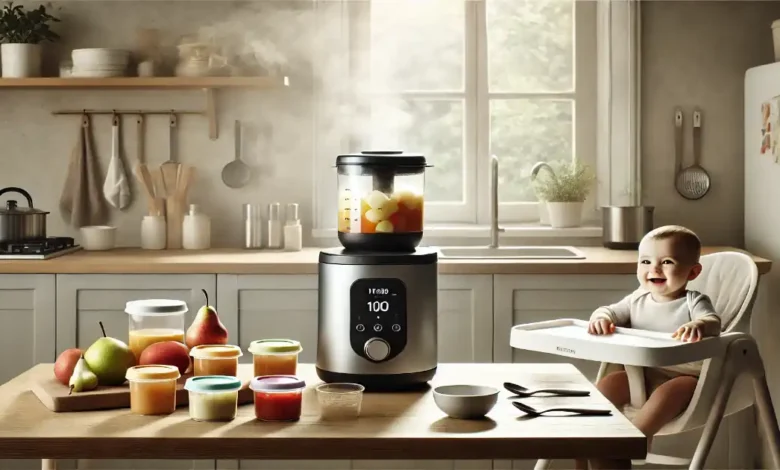The Ultimate Guide to Baby Food Makers: Everything You Need to Know

Why a Baby Food Maker is Essential for Your Baby’s Nutrition
As a parent, one of your top priorities is ensuring that your baby gets the best possible nutrition, especially during their early stages of growth. With the rising awareness of healthy eating, more parents are looking to make their baby’s food at home rather than relying on store-bought products. This is where a baby food maker comes into play. A baby food maker helps parents prepare fresh, homemade baby food quickly and efficiently, ensuring that their little one gets the right balance of nutrients without additives or preservatives.
This article will dive into everything you need to know about baby food makers: how they work, their benefits, key features to look for, and tips for choosing the right one for your baby’s needs. If you’re a new parent or soon-to-be parent, this comprehensive guide will help you make an informed decision.
1. What is a Baby Food Maker?
A baby food maker is a versatile kitchen appliance designed specifically for parents to prepare fresh and nutritious meals for their babies. These devices typically combine multiple functions, such as steaming, blending, chopping, reheating, and sometimes even defrosting, to help you create the perfect consistency for your baby’s meals.
Preparing homemade baby food lets parents know exactly what ingredients are going into their baby’s diet, ensuring high nutritional value without any hidden preservatives or artificial flavors. This device comes in various models, ranging from all-in-one units to manual devices that offer different levels of functionality based on parents’ preferences and needs.
2. Benefits of Using a Baby Food Maker
Healthier Food for Your Baby
By using a baby food maker, you can ensure that your baby’s food is free from harmful additives and preservatives often found in pre-packaged baby food. Homemade baby food allows you to use organic, fresh fruits, vegetables, and other healthy ingredients to create balanced meals packed with essential vitamins and minerals.
Saves Time and Money
While buying pre-made baby food might seem convenient, it can be expensive over time, especially if you opt for organic options. With a baby food maker, you can prepare large batches of food at once and store them for later use. This not only saves time but also reduces the cost of constantly purchasing store-bought baby food. Additionally, this device make the process fast and efficient, with many models completing the job in as little as 10 to 20 minutes.
Customization and Variety
Every baby has unique dietary needs and preferences. A baby food maker allows you to customize the ingredients and create meals that suit your baby’s taste and nutritional requirements. Whether your baby enjoys sweet fruits or prefers savory vegetables, you have full control over the texture, consistency, and combination of ingredients. This flexibility is especially beneficial if your baby has food allergies or sensitivities.
Eco-Friendly and Sustainable
Homemade baby food reduces the need for single-use packaging, which is common in store-bought options. By making your baby’s food at home, you contribute to less plastic waste and packaging material, making it an environmentally conscious choice. Furthermore, using fresh, local ingredients can reduce your carbon footprint.
3. Types of Baby Food Makers
There are different types of baby food makers available in the market, each with its own unique features and functionality. Understanding the types will help you choose the one that best suits your family’s needs.
All-in-One Baby Food Makers
All-in-one baby food makers are multi-functional devices that combine several tasks into one. These machines can steam, blend, and in some cases, even defrost and reheat baby food. They are designed to make the entire process of preparing baby food as simple and streamlined as possible. You only need to prepare the ingredients, place them in the machine, and let it do the rest. The convenience of these models makes them a popular choice for busy parents.
Manual Baby Food Makers
Manual devices, such as hand-operated mashers or grinders, are a more basic and cost-effective option. These tools usually require some physical effort but allow you to control the texture of the food more precisely. Manual models are ideal for parents who prefer to make small batches or who want a portable option when traveling.
4. Key Features to Look for in a Baby Food Preparation Device
When choosing the right tool for making homemade meals, there are certain features that will ensure you get the best value for your money and meet your baby’s nutritional needs effectively. Here are the key features to consider:
Steaming Function
Steaming is one of the healthiest ways to cook food for your baby, as it preserves most of the nutrients in fruits and vegetables. Look for a model that includes a steaming function to ensure your baby’s meals are cooked gently and retain their nutritional value.
Blending Capability
A powerful blending function is essential to achieve the smooth texture your baby needs, especially during the early stages of weaning. Many devices offer adjustable blending settings, allowing you to make everything from chunky purees to smooth meals based on your baby’s age and preferences.
Easy Cleaning and Maintenance
Babies require several meals a day, so an easy-to-clean appliance is a must. Look for machines that have dishwasher-safe parts or are designed for easy disassembly. Some models also come with self-cleaning features that simplify the process even further.
Safety Features
Since these appliances are often used daily, safety should be a priority. Check for features such as BPA-free materials, overheat protection, and automatic shut-off functions to prevent accidents.
Compact and Portable Design
If you have limited kitchen space or plan to travel with your meal-making device, consider a compact model that doesn’t take up too much room. Portable versions are also beneficial for families who need to prepare baby food on the go.
5. How to Use a Baby Food Maker: Step-by-Step Guide
Using a baby food maker is straightforward. Here’s a simple guide on how to prepare nutritious meals for your baby:
- Prepare the Ingredients: Wash, peel, and chop fruits, vegetables, or meat. Make sure to cut them into small, even-sized pieces.
- Steam the Ingredients: Place the ingredients in your baby food maker’s steamer basket. Steaming times may vary depending on the ingredients. Soft vegetables like spinach or peas will cook faster than harder vegetables like sweet potatoes or carrots.
- Blend the Ingredients: Once the ingredients are steamed, transfer them to the blending bowl (if it’s not an all-in-one model). Blend to the desired consistency. You can add water, breast milk, or formula to adjust the texture.
- Store the Baby Food: If you’ve made a large batch, store the leftover food in an airtight container in the refrigerator or freezer. Label each container with the date to ensure you use the food within the recommended time frame.
- Serve: Let the food cool to a suitable temperature before serving it to your baby. Always check the temperature to avoid burns.
6. Top Tips for Making Homemade Baby Food
- Start with Simple Ingredients: Introduce one new ingredient at a time to ensure your baby has no allergic reactions.
- Choose Organic and Fresh Produce: Use organic fruits and vegetables to minimize exposure to pesticides and chemicals.
- Gradually Introduce Different Textures: As your baby grows, they will need more textured food. Start with smooth purees and gradually move to chunkier textures.
- Freeze in Small Portions: If you’re making large batches, freeze the food in small portions using ice cube trays or silicone molds. This makes it easier to thaw only what you need for each meal.
7. Choosing the Right Food Preparation Device for Your Family
When selecting the best tool for preparing baby meals, consider your lifestyle, budget, and how often you plan to use it. Here are a few questions to ask yourself before making a purchase:
- How much food do you plan to make at once?
- Do you need a portable device for travel?
- Is easy cleaning a priority?
- Do you prefer an all-in-one unit, or are you comfortable with a manual option?
Your answers to these questions will help guide you to the ideal choice for your family’s needs.
8. Top Brands to Consider for Baby Meal Preparation Devices
Several top brands are known for producing high-quality products designed for baby food preparation:
- BEABA: Offers all-in-one units with steaming, blending, and reheating capabilities.
- Babymoov: Known for innovative features, including multiple compartments for cooking different foods simultaneously.
- Philips Avent: Focuses on simple and reliable tools that preserve the nutrients in the food.
- Nuby: Specializes in manual mashers for parents who prefer a more hands-on approach.
- Cuisinart: Known for durable, multi-functional devices that are easy to use and clean.
9. Conclusion
A baby food maker is an invaluable tool for parents looking to provide their baby with fresh, nutritious, and homemade meals. Whether you opt for an all-in-one model or a simple manual version, making baby food at home has numerous benefits, including healthier meals, cost savings, and the ability to customize your baby’s diet.
By choosing the right baby food maker, you can make the process of feeding your baby convenient and enjoyable. Take the time to research the different options available, consider the key features important to you, and you’ll soon find that preparing homemade baby food is not only easy but rewarding.
Frequently Asked Questions (FAQs)
What is the purpose of a baby food maker?
A baby food maker helps parents prepare fresh, homemade food for their babies. It simplifies the process of cooking, blending, and storing baby food, ensuring the meals are free from additives and preservatives and offer better nutritional value.
Can I prepare large batches of baby food using a baby food maker?
Yes, many baby food makers allow you to prepare large batches. You can store the food in the fridge or freezer, saving time and effort in preparing multiple meals in advance.
Is steaming baby food better than boiling?
Yes, steaming preserves more nutrients in food than boiling, making it a healthier option for your baby. For this reason, most baby food makers include a steaming function.
How do I clean a baby food maker?
Most baby food makers have dishwasher-safe parts or are designed for easy hand-washing. Be sure to read the manufacturer’s instructions for specific cleaning recommendations.
Can a baby food maker handle meat, fish, or only vegetables and fruits?
Yes, many baby food makers can cook and blend various foods, including vegetables, fruits, meat, and fish. Check the machine’s specifications to ensure it is designed for these capabilities.
Is it worth investing in an all-in-one baby food maker?
If you’re looking for convenience and the ability to steam, blend, and store baby food with minimal effort, an all-in-one baby food maker is worth the investment. It simplifies the process and saves time for busy parents.




